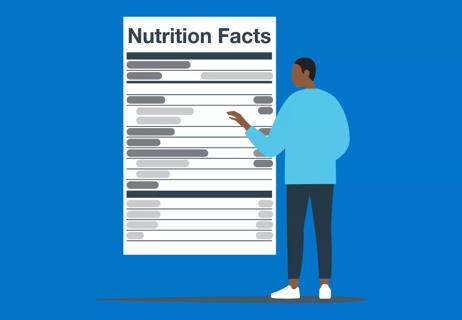Advertisement
These essential elements from fats, protein, carbs, vitamins and minerals help your body function properly

You may have heard your health-conscious friends talk about “counting macros” or the macronutrients in the foods they eat.
Advertisement
Cleveland Clinic is a non-profit academic medical center. Advertising on our site helps support our mission. We do not endorse non-Cleveland Clinic products or services. Policy
But what exactly are they doing and how does counting macros, or macronutrients, help you lead a healthy life? And what’s the difference between macronutrients and micronutrients?
Think of macronutrients as the lead actors in the production of your body and micronutrients as the supporting cast. Each is vital to a successful performance.
Registered dietitian Julia Zumpano, RD, LD, explains exactly what macronutrients and micronutrients are and why they’re so important to your health.
As the main nutrients found in food, macronutrients maintain your body’s structure and functioning. You typically need a large amount of macronutrients to keep your body working properly. But don’t stress: macronutrients come from proteins, fats and carbohydrates, which give your body energy in the form of calories.
Macros are typically measured in grams (g) and can be a useful way to track what you’re consuming.
“Someone might want to count their macronutrients to be sure they’re meeting their needs and not overconsuming or under consuming certain nutrients,” says Zumpano.
Overall, counting macros is a way to focus on the variety of foods you’re eating — and how much of each — instead of counting calories.
Even certain diets like the keto diet and the paleo diet use a macronutrient approach.
During digestion, foods that tend to fall into one of the three macronutrients are broken down to be used for different functions. Macronutrients include:
The Dietary Guidelines for Americans recommends the following:
To count macros, you need to determine how many calories you typically need in a day. Then, you set up goals on what percentage of calories from the three groups above you need to eat to meet your goals.
Goals can be different for everyone. Someone may want to count macros for weight control, while someone else might want to use them to help build muscles or even sustain their blood sugar levels.
And your percentages of macronutrients may change based on your age, sex, medical conditions, lifestyle and how active you are.
But counting macros involves a lot of math and can be difficult for most to follow. Additionally, there’s no solid research to say that this approach is effective. You can work with a registered dietitian or nutritionist to help you determine the best plan for you.
Advertisement
Micronutrients consist of vitamins and minerals and are measured in either milligrams (mg), micrograms (mcg) or International Units (IU).
Compared to macronutrients, your body needs a smaller amount of micronutrients for optimal performance. Though micronutrients don’t provide energy, they’re essential for functions like digestion, hormone production and brain function.
And while it can be beneficial to track your macronutrients, it can be hard to measure and gauge how many micronutrients you consume each day.
Just like macronutrients, micronutrients can be found in the foods that you eat every day — think fruits and vegetables.
“Most vitamins are water-soluble,” says Zumpano. “That means they get flushed out of your system when your body is done using what it needs.”
Some vitamins that are examples of micronutrients include:
Minerals that are good examples of micronutrients include:
Advertisement
“Your body can’t function without them,” says Zumpano. “Your body will work at its highest potential when all macros and micros are met on a consistent basis.”
So, how do you know if you’re getting enough of each?
“You want to look at your diet and be sure you are getting food sources from each food group,” notes Zumpano. “Taking a vitamin/mineral supplement can also be helpful, although macros can’t be obtained from a basic vitamin supplement.”
Zumpano suggests working with a registered dietitian to help determine if you’re meeting your dietary needs.
“A dietitian can perform a dietary assessment, review your medical history and consider any current health concerns,” she explains. “They can also review labs values and medications, and based on all those results, can develop a personalized meal plan and suggest any further labs to be drawn.”
But at the end of the day, what’s important is getting as many nutrients as possible by choosing a variety of foods from each food group — and by focusing on macronutrients, they can help you plan and make smart decisions.
Advertisement
Learn more about our editorial process.
Advertisement

A variety of healthy foods can help reduce inflammation and keep other conditions at bay

Information on serving size, calories and nutrients can help you make healthy choices

The general rule is 0.8 to 1 gram of protein per kilogram of body weight — but that may not be right for you, and it’s important to determine what’s right for you

Adding salt to your water isn’t going to have measurable benefits — but there may be plenty of downsides

Pickles are low in fat and calories and rich in some vitamins and minerals, but they’re usually high in sodium

Learning about your relationship with food can help improve your eating behaviors and patterns

With a sweet, tangy flavor, this tropical fruit is super versatile and high in antioxidants

A change in diet won’t cure COPD — but getting to or maintaining a healthy weight will help

Focus on your body’s metabolic set point by eating healthy foods, making exercise a part of your routine and reducing stress

PFAS chemicals may make life easier — but they aren’t always so easy on the human body

While there’s little risk in trying this hair care treatment, there isn’t much science to back up the claims